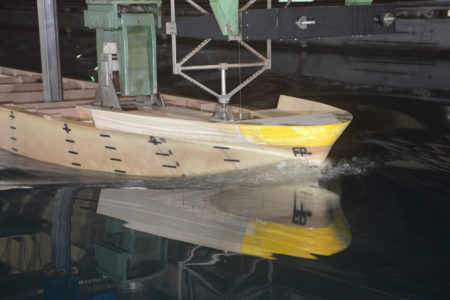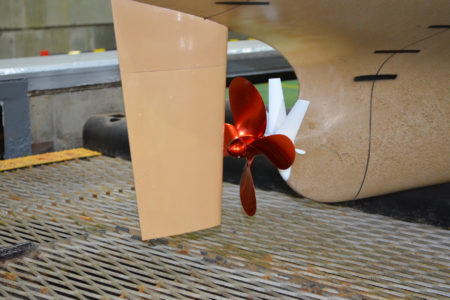Ships must have a hull form with good propulsive performance that allows them to travel long distances on less fuel. In the ship performance test, a large model ship is used to evaluate propulsive performance by checking the forces acting on the hull in calm water and the effects of propulsors on the hull.
Hull Performance Test
 A ship in motion is subjected to forces due to friction with the fluid and wave-making. Resistance tests measure the resistance acting on the hull, which is the combined force, and separate it into frictional and wave-making resistance in analysis. In the self-propulsion test, a propeller is installed, and thrust is applied to confirm the effect on the hull.
A ship in motion is subjected to forces due to friction with the fluid and wave-making. Resistance tests measure the resistance acting on the hull, which is the combined force, and separate it into frictional and wave-making resistance in analysis. In the self-propulsion test, a propeller is installed, and thrust is applied to confirm the effect on the hull. 
-450x300.jpg) Accurate wake distribution is indispensable for propeller design and the development of energy-saving devices. In the past, wake distribution was determined by multipoint measurement using five-hole tubes. We have introduced a state-of-the-art flow field measurement (Particle Image Velocimetry) that uses laser beams to simultaneously measure a single cross-section, enabling us to obtain more precise wake distribution.
Accurate wake distribution is indispensable for propeller design and the development of energy-saving devices. In the past, wake distribution was determined by multipoint measurement using five-hole tubes. We have introduced a state-of-the-art flow field measurement (Particle Image Velocimetry) that uses laser beams to simultaneously measure a single cross-section, enabling us to obtain more precise wake distribution.
-450x300.jpg)
 We can create various removable energy saving devices. These can be attached to the hull to check their energy saving effects.
We can create various removable energy saving devices. These can be attached to the hull to check their energy saving effects. 
Akishima Laboratory has passed the ISO 9001 management standard system for quality by Nippon Kaiji Kyokai and has been approved as an EEDI-certified test organization. EEDI certification test has been conducted by inspectors from Nippon Kaiji Kyokai (NK), American Bureau of Shipping (ABS), Bureau Veritas (BV), Lloyd's Register of Shipping (LR), DNV, and China Classification Society (CCS).
